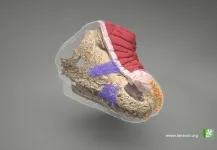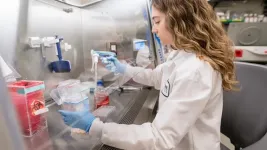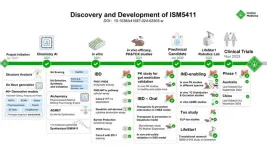(Press-News.org) When it comes to the human body, form and function work together. The shape and structure of our hands enable us to hold and manipulate things. Tiny air sacs in our lungs called alveoli allow for air exchange and help us breath in and out. And tree-like blood vessels branch throughout our body, delivering oxygen from our head to our toes. The organization of these natural structures holds the key to our health and the way we function. Better understanding and replicating their designs could help us unlock biological insights for more effective drug-testing, and the development of new therapeutics and organ replacements. Yet, biologically engineering tissue structures that are organized across multiple scales, from the arrangement of small cells all the way to the architecture of a large organ, has proven challenging using current fabrication technologies.
Now, Christopher Chen and his team at Boston University and the Wyss Institute at Harvard University have invented a new approach to solve this complex problem called ESCAPE (engineered sacrificial capillary pumps for evacuation). In new research published in Nature, the multidisciplinary team demonstrates how they used gallium, a soft silvery metal that melts just above room temperature, as a molding material for generating cell structures in a wide range of shapes and sizes that can be used to engineer tissue.
Senior author Christopher Chen, director of BU’s Biological Design Center and Core Faculty member at the Wyss Institute, explains how ESCAPE works and how their research will enable future advances in tissue engineering.
What is ESCAPE and how does it work?
Before we dive into ESCAPE, I think it is important to take a step back and talk about why building tissue itself is so difficult.
Why is building tissue a challenge?
There are two main hurdles when trying to engineer tissue. The materials themselves are incredibly fragile, and there is not a one-size fits all process.
First, biological materials, such as the extracellular matrix (ECM)—a complex network of proteins and other molecules that comes together to form cells and tissues—must be maintained in highly controlled environments. They cannot be exposed to high temperatures, harsh solvents or squeezed through tiny spaces. So, the way you must handle them is very limited.
The second challenge is finding a building process that works well for both small structures as well as large ones.
How did you overcome these challenges?
Inventing a single process that can handle the fragile materials and can build well at different scales is a hurdle. We wondered: could we decouple these two problems?
First, we examined building the geometry, the shape, using any material we wanted. Then, we copied the geometry over to the fragile biological material through molding. This approach allows us to build tissue successfully in many different shapes, using soft materials. That’s the heart of the ESCAPE work.
How does ESCAPE copy shapes?
First, the desired shape is generated using fabrication processes and materials designed for patterning. Gallium is then used to form a solid metal cast of the shape. Next, the desired biomaterial is polymerized around the gallium cast. Finally, gallium is melted and removed cleanly, leaving behind an intact biomaterial scaffold. Cells can then be added to this scaffold and cultured to form tissue architectures.
Why did you decide to use gallium?
Gallium is truly the perfect material for this. It is solid at room temperature, so it can be handled easily and works well as a casting material. But what makes it so special is that it is biocompatible and can be melted at cell-friendly, low temperatures. So, it is easy to extract gallium without destroying a delicate mold. Even better yet, Gallium can be switched to a high surface tension state, which means that it can easily be triggered to pump itself out of confinement. This process is called capillary pumping, the “CAPE” of “ESCAPE” (engineered sacrificial capillary pumps for evacuation).
What structures have you built using ESCAPE?
ESCAPE can be used on several tissue architectures, but we started with vascular forms because blood vessel networks feature many different length scales. Engineering the vascular tree (and its hierarchies) is a well-known challenge in the field of biological engineering.
Our blood vessel demonstrations include trees with many branches, including dead ends and portions that experience fluid flow. This allows us to model a range of healthy structures as well as diseased abnormalities.
Another approach involves independent tissue networks that are interwoven with each other. Most tissues feature not one, but many distinct networks that come near each other, yet are not in direct contact. These networks are lined with different cells. To showcase this, we fabricated interwoven blood and lymphatic networks.
Finally, vascular networks nourish other cells within a tissue. To capture this, we built cavities packed with cardiac cells that have high nutrient needs that were met with blood vessels in close proximity.
What’s next for ESCAPE?
We envision using ESCAPE with new cell types and new shapes representative of different organs. We also want to use it in organoid cultures. Then, we plan to expand to more materials beyond the three we tried in this research.
With this research, we have the basic design rules in place to predict the reliability of ESCAPE. Simulating the capillary pumping process will allow us to test different designs computationally in advance.
Republishers are kindly reminded to uphold journalistic integrity by providing proper crediting, by including a direct link back to the original source URL.
END
Innovative tissue engineering: Boston University's ESCAPE method explained
Molding complex tissues using gallium
2024-12-11
ELSE PRESS RELEASES FROM THIS DATE:
Global healthspan-lifespan gaps among 183 WHO member states
2024-12-11
About The Study: This study identifies growing healthspan (years lived in good health)-lifespan gaps around the globe, threatening healthy longevity across worldwide populations. Women globally exhibited a larger healthspan-lifespan gap than men.
Corresponding Author: To contact the corresponding author, Andre Terzic, MD, PhD, email terzic.andre@mayo.edu.
To access the embargoed study: Visit our For The Media website at this link https://media.jamanetwork.com/
(doi:10.1001/jamanetworkopen.2024.50241)
Editor’s Note: Please see the article ...
Stanford scientists transform ubiquitous skin bacterium into a topical vaccine
2024-12-11
Imagine a world in which a vaccine is a cream you rub onto your skin instead of a needle a health care worker pushes into your one of your muscles. Even better, it’s entirely pain-free and not followed by fever, swelling, redness or a sore arm. No standing in a long line to get it. Plus, it’s cheap.
Thanks to Stanford University researchers’ domestication of a bacterial species that hangs out on the skin of close to everyone on Earth, that vision could become a reality.
“We all hate needles — everybody does,” said Michael Fischbach, PhD, the Liu (Liao) Family Professor and a professor of bioengineering. “I haven’t found a single person ...
Biological diversity is not just the result of genes
2024-12-11
How can we explain the morphological diversity of living organisms? Although genetics is the answer that typically springs to mind, it is not the only explanation. By combining observations of embryonic development, advanced microscopy, and cutting-edge computer modelling, a multi-disciplinary team from the University of Geneva (UNIGE) demonstrate that the crocodile head scales emerge from the mechanics of growing tissues, rather than molecular genetics. The diversity of these head scales observed in different crocodilian species therefore arises from the evolution of mechanical parameters, such as the growth ...
Analysis reveals an additional mechanism behind statin therapy’s heart-related benefits in people with HIV
2024-12-11
Investigators who previously found that a daily statin pill helps prevent heart attacks and strokes in people with HIV have now discovered a potential mechanism that may help to stabilize plaques and prevent their rupture in blood vessels. The research led by a team from Mass General Brigham is published in JAMA Cardiology.
“Individuals with HIV tend to have an excess of noncalcified plaques that are vulnerable to rupture at a younger age, putting them at high risk for strokes, heart attacks, and sudden cardiac death,” said senior author Steven Grinspoon, MD, chief of the Metabolism Unit at Massachusetts General Hospital, a founding member of the Mass General Brigham healthcare ...
Understanding how the immune system switches between rest and action
2024-12-11
SAN FRANCISCO—Cells in the immune system don’t always fight; they often rest and wait for threats, like viruses or bacteria. When such threats emerge, the cells activate to defend the body. This delicate balance between rest and activation is crucial to our health—immune cells must be poised for activation to protect against threats, but if they’re overly active, autoimmune diseases can result.
But what controls this important balance?
In a new study published in Nature, scientists from Gladstone Institutes and UC San Francisco ...
Wiley expands its KnowItAll solutions with new tools for LC-MS analysis, enterprise data management, and additional spectral advances
2024-12-11
HOBOKEN, N.J.—Wiley, one of the world’s largest publishers and a global leader in research and learning, today announced the release of the new version of its KnowItAll software, with numerous advances to accelerate spectral analysis and optimize workflows.
KnowItAll 2025, the latest version of Wiley’s comprehensive software suite for spectral analysis and analytical data management, introduces a groundbreaking new tool to automate LC-MS analysis, enhanced data management, and numerous other features to streamline analysis across multiple ...
A new class of antivirals could help prevent future pandemics
2024-12-11
The arrival of Paxlovid in December 2021 marked another turning point in the COVID-19 pandemic—an effective antiviral that has since successfully treated millions. But like many antivirals before it, scientists know that at some point, Paxlovid is likely to lose some efficacy due to drug resistance. Researchers working to stay ahead of such emerging threats have now identified a wholly new way to treat SARS-CoV-2 infections—work that may have even broader implications.
In fact, a new study by the Tuschl ...
Nature Biotechnology | Generative chemistry enables Insilico to develop gut-restricted PhD inhibitors promising for intestinal mucosal barrier repair and immunomodulation
2024-12-11
The study presents the journey of designing and optimizing novel gut-restricted PHD inhibitors using the comprehensive generative chemistry engine Chemistry42.
From initiation to preclinical candidate nomination, the program spanned only 12 months, during which approximately 115 molecules were synthesized and screened.
Preclinical studies demonstrate ISM5411 to be gut-restricted and PHD-specific, thus reducing cardiovascular and systematical tumorigenic risks.
Two Phase 1 clinical trials of ISM5411 for IBD are currently being conducted in parallel in Australia and China, with the last subject out in both ...
2 U-M faculty members elected to National Academy of Inventors
2024-12-11
ANN ARBOR—Two University of Michigan faculty members have been elected to the National Academy of Inventors, the highest professional distinction awarded solely to inventors.
Robert Bartlett, professor emeritus of surgery at the Medical School, and Zhen Xu, professor of biomedical engineering at the College of Engineering and professor of radiology and neurosurgery at the Medical School, were elected this month to the academy.
Bartlett and Xu were nominated for being innovative researchers with extensive work translating discoveries into ...
Breakthroughs in cell-penetrating monoclonal antibody therapies
2024-12-11
“Monoclonal antibodies (mAb) have emerged as a promising tool in advancing personalized medicine.”
BUFFALO, NY – December 11, 2024 – A news feature on the research paper “Next-generation cell-penetrating antibodies for tumor targeting and RAD51 inhibition” by Rackear et al. was published in Oncotarget’s Volume 15 on November 22, 2024, titled “Advancements in cell-penetrating monoclonal antibody treatment.“
This new publication by Sai Pallavi Pradeep and Raman Bahal from the Department of Pharmaceutical Sciences at the University of Connecticut highlights significant advancements in ...
LAST 30 PRESS RELEASES:
Making lighter work of calculating fluid and heat flow
Normalizing blood sugar can halve heart attack risk
Lowering blood sugar cuts heart attack risk in people with prediabetes
Study links genetic variants to risk of blinding eye disease in premature infants
Non-opioid ‘pain sponge’ therapy halts cartilage degeneration and relieves chronic pain
AI can pick up cultural values by mimicking how kids learn
China’s ecological redlines offer fast track to 30 x 30 global conservation goal
Invisible indoor threats: emerging household contaminants and their growing risks to human health
Adding antibody treatment to chemo boosts outcomes for children with rare cancer
Germline pathogenic variants among women without a history of breast cancer
Tanning beds triple melanoma risk, potentially causing broad DNA damage
Unique bond identified as key to viral infection speed
Indoor tanning makes youthful skin much older on a genetic level
Mouse model sheds new light on the causes and potential solutions to human GI problems linked to muscular dystrophy
The Journal of Nuclear Medicine ahead-of-print tip sheet: December 12, 2025
Smarter tools for peering into the microscopic world
Applications open for funding to conduct research in the Kinsey Institute archives
Global measure underestimates the severity of food insecurity
Child survivors of critical illness are missing out on timely follow up care
Risk-based vs annual breast cancer screening / the WISDOM randomized clinical trial
University of Toronto launches Electric Vehicle Innovation Ontario to accelerate advanced EV technologies and build Canada’s innovation advantage
Early relapse predicts poor outcomes in aggressive blood cancer
American College of Lifestyle Medicine applauds two CMS models aligned with lifestyle medicine practice and reimbursement
Clinical trial finds cannabis use not a barrier to quitting nicotine vaping
Supplemental nutrition assistance program policies and food insecurity
Switching immune cells to “night mode” could limit damage after a heart attack, study suggests
URI-based Global RIghts Project report spotlights continued troubling trends in worldwide inhumane treatment
Neutrophils are less aggressive at night, explaining why nighttime heart attacks cause less damage than daytime events
Menopausal hormone therapy may not pose breast cancer risk for women with BRCA mutations
Mobile health tool may improve quality of life for adolescent and young adult breast cancer survivors
[Press-News.org] Innovative tissue engineering: Boston University's ESCAPE method explainedMolding complex tissues using gallium



